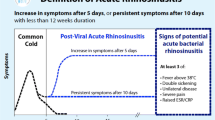Abstract
Enterotoxins produced by Staphylococcus aureus (SA) can act as super-antigens and thus influence the course of chronic rhinosinusitis with nasal polyps (NP). The aim of this study was to determine if antibiotic treatment administered after endoscopic sinus surgery (ESS) for NP can positively influence the course of the disease compared to placebo. After ESS, 23 patients who tested positive, in a perioperative culture, for SA strains producing enterotoxins A–E and TSST-1, were randomized into two groups. Group A which in addition to standard treatment received oral anti-staphylococcal antibiotics for 3 weeks. Group B received a placebo. Both groups were compared preoperatively, and at 3 and 6 months after surgery using a symptom-specific score, an endoscopic score and the SNOT-22 quality of life questionnaire. Slightly better results were achieved in patients who received antibiotic therapy. However, the differences were not statistically significant. Regardless of post-operative treatment, approximately 30% of patients had a SA-negative culture 6 months after surgery.



Similar content being viewed by others
References
Bachert C, Gevaert P, Holtappels G, Johansson SG, van Cauwenberge P (2001) Total and specific IgE in nasal polyps is related to local eosinophilic inflammation. J Allergy Clin Immunol 107:607–614
Bachert C, Gevaert P, Holtappels G, Cuvelier C, van Cauwenberge P (2000) Nasal polyposis: from cytokines to growth. Am J Rhinol 14:279–290
Conley DB, Tripathi A, Ditto AM, Reid K, Grammer LC, Kern RC (2004) Chronic rhinosinusitis with nasal polyps: staphylococcal exotoxin immunoglobulin E and cellular inflammation. Am J Rhinol 18:273–278
Perez-Novo CA, Kowalski ML, Kuna P, Ptasinska A, Holtappels G, van Cauwenberge P et al (2004) Aspirin sensitivity and IgE antibodies to Staphylococcus aureus enterotoxins in nasal polyposis: studies on relationship. Int Arch Allergy Immunol 133:255–260
Tripathi A, Conley DB, Grammer LC, Ditto AM, Lowery MM, Seiberling KA et al (2004) Immunoglobulin E to staphylococcal and streptococcal toxins in patients with chronic sinusitis/nasal polyposis. Laryngoscope 114:1822–1826
Van Zele T, Gevaert P, Watelet JB, Claeys G, Holtappels G, Claeys C et al (2004) Staphylococcus aureus colonization and IgE antibody formation to enterotoxins is increased in nasal polyposis. J Allergy Clin Immunol 114:981–983
Bachert C, Gevaert P, van Cauwenberge P (2002) Staphylococcus aureus enterotoxins: a key in airway disease? Allergy 57:480–487
Hauk PJ, Hamid QA, Chrousos GP, Leung DY (2000) Induction of corticosteroid insensitivity in human PBMCs by microbial superantigens. J Allergy Clin Immunol 105:782–787
Plouin-Gaudon I, Clement S, Huggler E, Chaponnier C, Francois P, Lew D et al (2006) Intracellular residency is frequently associated with recurrent Staphylococcus aureus rhinosinusitis. Rhinology 44:249–254
Hess DJ, Henry-Stanley MJ, Erickson EA, Wells CI (2003) Intracellular survival of Staphylococcus aureus within cultured enterocytes. J Surg Res 114:42–49
Dziewanowska K, Patti JM, Deobald CF, Bayles KW, Trumble WR, Bohach GA (1999) Fibronectin binding protein and host cell tyrosine kinase are required for internalization of Staphylococcus aureus by epithelial cells. Infect Immun 67:4673–4678
Menzies BE, Kourteva I (1998) Internalization of Staphylococcus aureus by endothelial cells induces apoptosis. Infect Immun 66:5994
Yao L, Bengualid V, Lowy FD, Gibbons JJ, Hatcher VB, Berman JW (1995) Internalization of Staphylococcus aureus by endothelial cells induces cytokine gen expression. Infect Immun 63:1835
Johanssen LV, Illum P, Kristensen S, Winther L, Petersen SV, Synnerstad B (1993) The effect of Budesonide (Rhinocort) in the treatment of small and medium sized nasal polyps. Clin Otolaryngol 17:524–527
Zollner TM, Wichelhaus A, Hartung A, von Mallinckrodt C, Wagner TOF, Brade V et al (2000) Colonization with superantigen-producing Staphylococcus aureus is associated with increased severity of atopic dermatitis. Clin Exp Allergy 30:994–1000
Morishita Y, Tada J, Sato A, Toi Y, Kanzaki H, Akiyama H et al (1999) Possible influences of Staphylococcus aureus on atopic dermatitis—the colonizing features and the effects of staphylococcal enterotoxins. Clin Exp Allergy 29:110–1117
Breuer K, Haussler S, Kapp A, Werfel T (2002) Staphylococcus aureus: colonizing features and influence of an antimicrobial treatment in adults with atopic dermatitis. Br J Dermatol 147:55–61
Subramanian HN, Schechtman KB, Hamilos DL (2002) A retrospective analysis of treatment outcomes and time to relapse after intensive medical treatment for chronic sinusitis. Am J Rhinol 16:303–312
McNally PA, White MV, Kaliner MA (1997) Sinusitis in allergist’s office: analysis of 200 consecutive cases. Allergy Asthma Proc 18:169–175
Fokkens WJ, Lund VJ, Mullol J et al (2007) Position paper on rhinosinusitis and nasal polyps. Rhinology 45(Suppl 20):1–136
Ragab SM, Lund VJ, Scadding G (2004) Evaluation of the medical and surgical treatment of chronic rhinosinusitis: a prospective, randomised, controlled trial. Laryngoscope 114:923–930
Videler WJM, Van Drunen CM, Reitsma JB, Fokkens WJ (2008) Nebulized bacitracin/colimycin: a treatment option in recalcitrant chronic rhinosinusitis with Staphylococcus aureus? A double blind, randomized, placebo-controlled, cross-over pilot study. Rhinology 46:92–98
Bachert C, Zhang N, Patou J, Van Zele T, Gevaert P (2008) Role of staphylococcal superantigens in upper airway disease. Curr Opin Allergy Clin Immunol 8:34–38
Patou J, Van Zele T, Gevaert P, Holtappels G, Cauwenberge van, Bachert C (2008) Staphylococcus aureus enterotoxins B, protein A and lipoteichoic acid stimulations in nasal polyps. J Allergy Clin Immunol 121:110–115
Bolard F, Gosset P, Lamblin C, Bergoin C, Tonnel AB, Wallaert B (2001) Cell and cytokine profiles in nasal secretions from patients with nasal polyposis: effects of topical steroids and surgical treatment. Allergy 56:333–338
Conflict of interest statement
The authors declare that they have no conflict of interest.
Author information
Authors and Affiliations
Corresponding author
Rights and permissions
About this article
Cite this article
Schalek, P., Petráš, P., Klement, V. et al. Short-term antibiotics treatment in patients with nasal polyps and enterotoxins producing Staphylococcus aureus strains. Eur Arch Otorhinolaryngol 266, 1909–1913 (2009). https://doi.org/10.1007/s00405-009-1049-x
Received:
Accepted:
Published:
Issue Date:
DOI: https://doi.org/10.1007/s00405-009-1049-x




